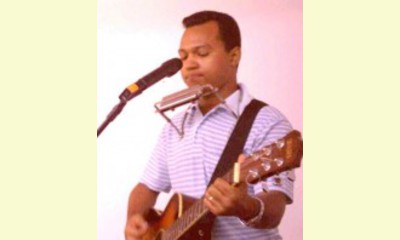|
|
Clésio Tapety: Singer and Composer for the Culture of Peace
un articulo por www.culturadapaz.com e www.letras.com.br
Clésio Tapety was born in Teresina (Piauí, Brazil) and lives now in São Paulo. He graduated with a degree in law, specializing in civil law, civil procedure, human rights and environmental law.

click on photo to enlarge
He is a practicing musician, singer, songwriter and instrumentalist. Also a graphic artist with a background in design, advertising and painting. He is a vegetarian cook with training as a professional chef and vegetarian cuisine.
He conducts research and creates cultural and artistic works to promote human rights, culture of peace, nonviolence, animal rights, vegetarianism and spirituality.
According to Mr. Tapety, "We live in the midst of a culture of violence and many do not realize it. Violence is treated as entertainment and spectacle. Children grow up watching cartoons where violence is the focus. The sale of violent material (movies, video games, toy guns) is very profitable. The mass media sells violence as spectacle. The stories that we studied in school are based on war heroes and not on the heroes of peace. Peace, therefore, is the hidden side of history. The fictional heroes that children and young people learn to admire are those who fight violence with violence. The most popular children's songs have terrorist lyrics. The arts are generally dominated by violent form and content. Sports are most often presented as a form of fighting, wars of competition, where participants are eliminated until there is a clear winner and loser. In the field of religion, many preach love, but few practice it, instead using religion to justify holy wars.
"We are all born with the potential of love and aggression, and we need to expand the first and channel the second
for constructive purposes. And all of us, religious, atheists, scientists, artists, teachers, trash collectors, traders, businessmen, children, youth and adults, whatever the environment and the circumstances in which we are situated, we should work the construction of Culture of Peace not simply because it is our belief, philosophy and ideal, because this is something that goes beyond mere particular belief. It is a matter of necessity (individual, social and environmental) that should beyond the realm of philosophical, political or religious partisanship.
"Working to build a Culture of Peace is not to deny the existence of violence. Violence exists! It is one of facets of reality and is present in a multitude of forms: physical, psychological, social, economic, environmental, institutional, legal, explicit, dressed, religious, artistic, sporting, acts of commission and omission. However, the belief that the world is irredeemably violent and that there is no solution for it is to close your eyes and ears. Instead, we should listen to the daily efforts of millions of people who are working for peace and for a better world. We should not look at peace as an unattainable ideal, but as a reality.
"Our challenge is to find ways to globalize love, forgiveness and tolerance with the same efficiency as is now dedicated the globalization of violence.
"We need, regardless of our professions or beliefs, to act as social activists, environmentalists and
peacebuilders. And certainly, we can make this planet a better world."
(Click here for a Portuguese version of this article)
|








|
DISCUSSION
Pregunta(s) relacionada(s) al artículo :
Creating a culture of peace, How can we do it as professionals?
* * * * *
Comentario más reciente:
:
One avenue is to replace the military model in schools with the nonviolence model. The Chicago Chapter of Veterans For Peace is working to do that. ChicagoVFP.org
Gene Sharp has written many books on nonviolence. If anyone has developed a curriculum on nonviolence, please contact me.
Coordinator@ChicagoVFP.org

|
|









